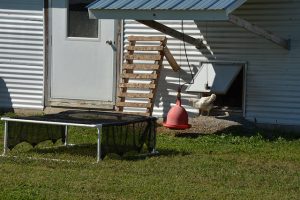
Georgie Cartanza, an organic poultry farmer in Kent County, DE. Georgie has four 65’x500 chicken houses, each can hold up to 37,000 chickens, totaling up to 148,000 chickens on her farm during a single flock. Georgie produces over 5 million pounds of organic broilers each year by growing 5 and a half flocks per year. Chicken houses have advanced technology built within allowing farmers to control the optimal environment for the chickens during all stages of growth. Chickens themselves produce a lot of heat so the cooling system within the houses is important in keeping the chickens happy and healthy. For example, Gorgie’s houses cooling system can cycle the air in under a minute. Aside from the organic feed requirements, some of the organic requirements are to have enrichments within and outside of the house and to have outdoor access. Enrichments can be as simple as ramps and boxes.
So you may be thinking how does Georgie produce 5 Million pounds of broiler meat each year?
Well, that’s due to the advancements and improvements in technology, genetics, housing, and nutrition. No hormones and no steroids. Applicable to both organic and commercial poultry farming.
Also, what is done with all the manure generated?
Each year, 5 and a half flocks generate 4 million pounds of manure per year. That is about 1 ton per 1,000 chickens per flock. Then a nutrient-packed compost is made with the manure and mortality. That is then sold to a local dairy farmer as a fertilizer. The manure is improving the soil health and structure by providing vital macro and micronutrients to the soil.







